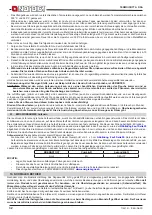
21
a supply of fresh air through an external air inlet placed near the appliance or by placing piping for combustion air which leads outside or
to a nearby airy place,
with the exception of the boiler room or garage (FORBIDDEN).
The intake of air for combustion in the place of installation must not be obstructed during operation of the thermo-product. It is absolutely
essential that in environments in which thermo-products are operated with a natural chimney draught, as much air as is necessary for
combustion is introduced, i.e. up to 25 m³/hour. The natural recirculation of air must be guaranteed by some fixed openings to the outside.
Their size is established by regulations regarding the subject. Ask for information from a chimneys weep. The openings must be protected
with grills and must never be blocked up. An extractor hood (suction) installed in the same room or in a neighbouring one causes a
depression in the environment. This causes the leakage of burnt gas (dense smoke, smell); it is therefore necessary to ensure a greater
flow of fresh air.
The depression of an extractor hood can, in the worst case scenario, transform the flue of the thermo-product into an external
air inlet, re sucking the flue gases into the environment with very serious consequences for persons.
8. ALLOWED / NOT ALLOWED FUELS
Allowed fuels are logs. Use exclusively dry logs (max. content of water 20%). Maximum 3 logs should be loaded. The pieces of wood
should have a length of ca. 20-30 cm and a maximum circumference of 30-35 cm.
Compressed not worked-out wood briquettes must be used carefully to avoid overheating that may damage the device, since
these have a very high calorific value
.
The wood used as fuel must have a humidity content lower than the 20% and must be stored in a dry place. Humid wood tends to burn
less easily, since it is necessary a greater quantity of energy to let the existing water evaporate. Moreover, humid content involves
the disadvantage that, when temperature decreases, the water condensates earlier in the hearth and therefore in the stack causing a
remarkable deposit of soot with following possible risk of fire of the same.
Fresh wood contains about 60% of H
2
O, therefore it is not suitable to be burnt.
It is necessary to place this wood in a dry and ventilated place (for example under a roofing) for at least two years before using it.
Besides others, it is not possible to burn: carbon, cuttings, waste of bark and panels, humid wood or wood treated with paints,
plastic materials; in this case, the warranty on the device becomes void.
Paper and cardboard must be used only to light the fire.
The combustion of waste is FORBIDDEN
and would even damage the appliance and the flue, causing health damages and claims by
the neighborhood owing to the bad smell. The wood is not a fuel which allows a continuous operation of the appliance, as consequence
the heating all over the night is not possible.
Variety
Kg/mc
kWh/kg
moistness
20%
Beech
750
4,0
Oak
900
4,2
Elm
640
4,1
Poplar
470
4,1
Larch*
660
4,4
Spruce*
450
4,5
Scots pine *
550
4,4
*
RESINOUS WOOD NOT SUITABLE FOR THE BURNING
ATTENTION : the continuous and protracted use of aromatic wood (eucalyptus, myrtle etc.) quickly damages the cast iron parts
(cleavage) of the product
.
9. LIGHTING
ATTENTION
:
never light for any reason if the installation is not completely full of water in order to avoid a serious damage of
the whole structure. IABSOLUTELY DO NOT LIGHT THE FIRE IN THE THERMO-FIREPLACE IN THE TOTAL OR PARTIAL
ABSENCE OF WATER
(NOT EVEN FOR CHECKING), AS IT COULD BE IRREMEDIABLY RUINED. IN SUCH CASE THE
WARRANTY ON THE APPLIANCE IS VOIDED.
WARNING:
After the first ignition you can smell bad odours (owing to the drying of the glue used in the garnitures or of the paint) which
disappear after a brief using of the appliance.
It must be ensured, in any case, a good ventilation of the environment.
Upon the
first ignition we suggest loading a reduced quantity of fuel and slightly increasing the calorific value of the equipment
To perform a correct first lighting of the products treated with paints for high temperature, it is necessary to know the following information:
• the construction materials of the involved products are not homogeneous, in fact there are simultaneously parts in cast iron, steel,
refractory material and majolica;
• the temperature to which the body of the product is subject is not homogeneous: from area to area, variable temperatures within the
range of 300°C - 500°C are detected;
• during its life, the product is subject to alternated lighting and extinguishing cycles in the same day, as well as to cycles of intense use
or of absolute standstill when season changes;
• the new appliance, before being considered seasoned has to be subject to many start cycles to allow all materials and paints to
complete the various elastic stresses;
Summary of Contents for TermoISOTTA - DSA
Page 2: ......
















































